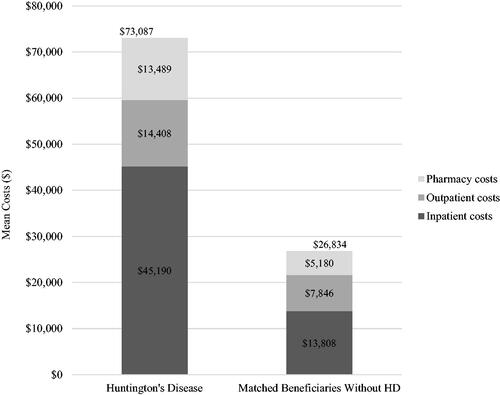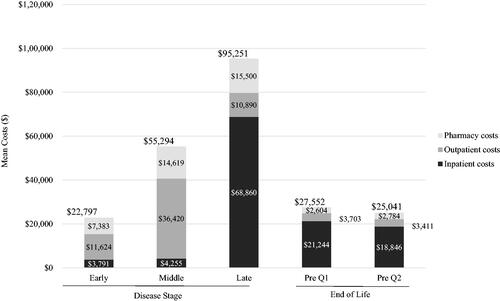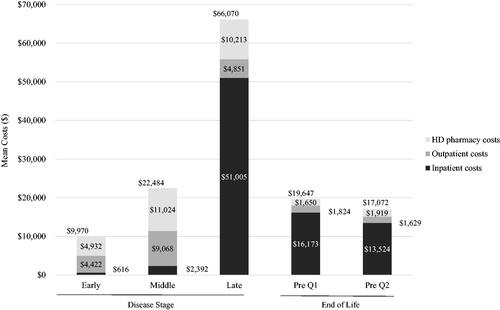Figures & data
Table 1. Baseline characteristics among Medicaid beneficiaries, with vs. without Huntington’s disease.
Figure 2. Mean annual all-cause healthcare costs among Medicaid beneficiaries with vs. without Huntington’s Diseasea. aBeneficiaries without HD were exactly matched to beneficiaries diagnosed with HD on a 1:1 ratio by age, sex, calendar year, and US state.

Table 2. Healthcare utilization and costs among Medicaid beneficiaries, with vs. without Huntington’s Disease (adjusted to 2014 Dollars).
Figure 3. Mean healthcare costs by disease stage and at end of life (all-cause)a–c. aLate-stage disease markers identified first: nursing home, feeding tube, incontinence, bedsore, hospice care, at least two falls within a 1-month period and dysphagia. Middle stage disease markers identified second: home assistance, physical therapy, dementia, gait disorder, dysarthria, speech therapy, and having two falls in a 1-month period. Beneficiaries without late or middle stage disease markers were defined as early-stage disease. bAt the end of life, Pre Q1 was defined as the 3-month period immediately preceding death and Pre Q2 was defined as the 3-month period preceding Pre Q1. cAnnual costs by disease stage; quarterly costs for end-of-life analysis.

Figure 4. Mean healthcare costs by disease stage and at end of life (Huntington’s disease-related)a–e. aLate-stage disease markers identified first: nursing home, feeding tube, incontinence, bedsore, hospice care, at least two falls within a 1-month period, and dysphagia. Middle stage disease markers identified second: home assistance, physical therapy, dementia, gait disorder, dysarthria, speech therapy, and having two falls in a 1-month period. Beneficiaries without late or middle stage disease markers were defined as early-stage disease. bAt the end of life, Pre Q1 was defined as the 3-month period immediately preceding death and Pre Q2 was defined as the 3-month period preceding Pre Q1. cAnnual costs by disease stage; quarterly costs for end-of-life analysis. dHD-related: any utilization related to HD diagnosis or symptoms associated with HD. eCosts reported for full HD pharmacy category including: tetrabenazine, deutetrabenazine, neuroleptics, amantadine, riluzole, donepezil, minocycline, nabilone, coenzyme Q10, and energy metabolites.

Table 3. Baseline characteristics among Medicaid beneficiaries with Huntington’s disease, by disease stage and at end of life.
Table 4. Healthcare utilization and costs among Medicaid beneficiaries with Huntington’s disease, by disease stage and at end of life.
Data availability statement
Data is available from the Centers for Medicare and Medicaid Services (CMS).

